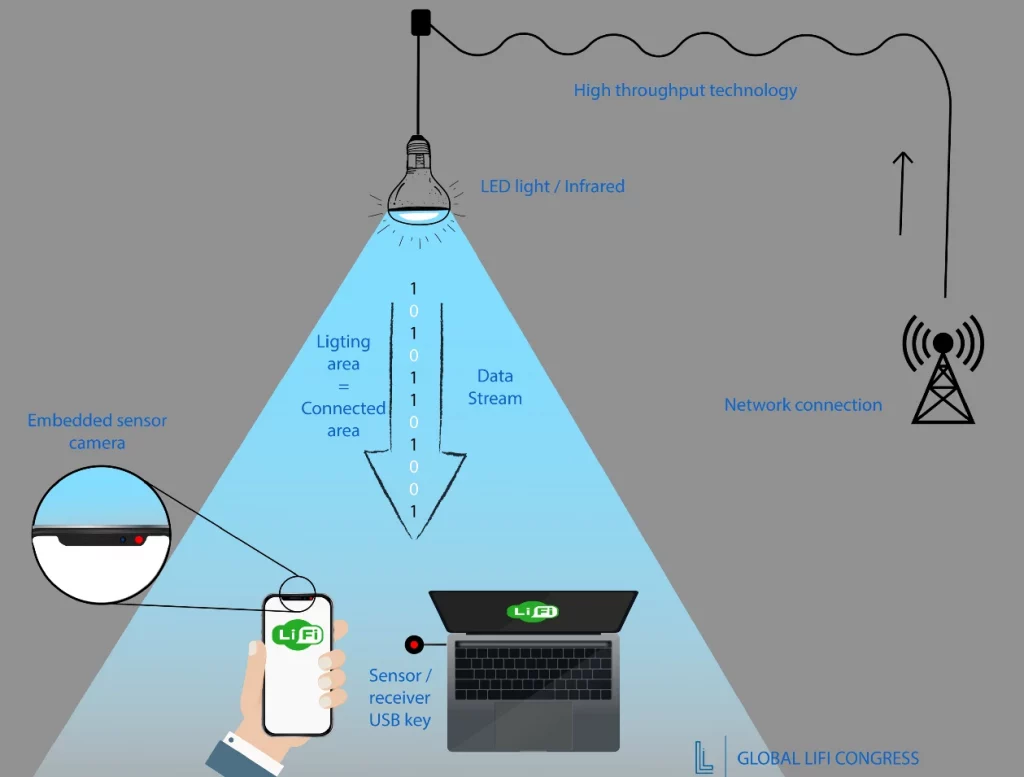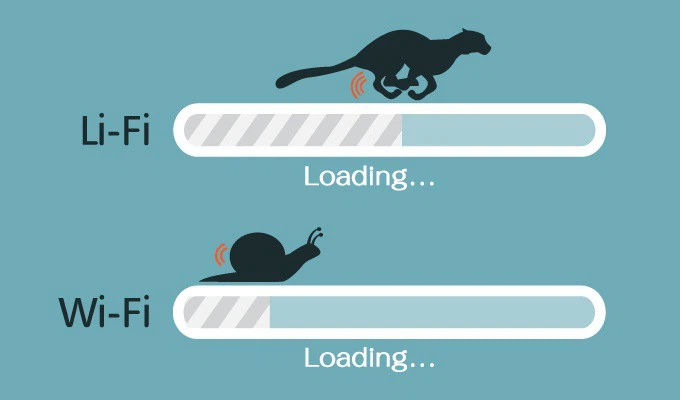Recently, the Institute of Electrical and Electronics Engineers announced a new wireless communication standard 802.11bb (known as Li-Fi) based on light, reaching speeds of up to 224 gigabits per second. , which is about 100 times faster than current Wi-Fi network speeds.
Thank you for reading this post, don't forget to subscribe!Light Fidelity (Li-Fi): Illuminating High-Speed Connectivity
What is Light Fidelity (Li-Fi) technology?
Li-Fi stands for Light Fidelity. Li-Fi is a portable wireless communication technology that uses light instead of radio frequencies to transmit data. The experience of using Li-Fi is similar to Wi-Fi but offers many more advantages. Similar to other wireless communication technologies, Li-Fi can be used in many applications such as internet access, phone-to-phone or phone-to-TV communication or in other use cases. emerging like augmented or mixed virtual reality.

Imagine being able to connect to high-speed Internet simply by turning on a light switch. Li-Fi is a wireless optical network technology that uses LEDs to transmit data. Essentially, Li-Fi technology uses light, not radio waves, to transmit information. This approach offers several benefits, such as the ability to work in areas susceptible to electromagnetic interference, such as hospitals and aircraft cabins, while also delivering faster data transfer speeds. .
Li-Fi uses common household LED light bulbs to enable data transmission, reaching speeds of up to 224 gigabits per second. Li-Fi bulbs are equipped with a light-modulating chip to transmit optical data that is invisible to the human eye. Li-Fi data is transmitted through LED bulbs and received by optical sensors.
A brief history of Light Fidelity (Li-Fi) technology
Li-Fi technology was introduced by Professor Harald Haas – Chairman of the Department of Mobile Communications at the University of Edinburgh (UK) in a talk at TED Global in 2011. Professor Haas is the co-founder of pureLiFi, a technology The company manufactures Li-Fi products for integration with LED lighting systems.
In 2013, pureLiFi released the world’s first commercial Li-Fi technology. This marks a groundbreaking milestone in wireless communication technology. Two years later, pureLiFi partnered with French lighting company Lucibel to launch the world’s first industrialized Li-Fi solution, which has been deployed in multiple locations, including its headquarters. Microsoft in Paris (France).
The next generation Li-Fi system called Li-Fi – XC, released in 2017, is a plug-and-play system certified to work with USB devices and has Can be integrated into laptops, tablets and smart devices.
Li-Fi technology offers many benefits, including providing faster Internet speeds and increased security, especially in areas where radio frequencies may be unsafe or unavailable. With its rapid growth and expansion, Li-Fi technology will certainly revolutionize wireless communications in the coming years.
The history of Li-Fi has been marked by various milestones since Professor Haas introduced the technology in 2011. Since then, pureLiFi has been at the forefront of developing and commercializing products Li-Fi. Many other companies have also started working on Li-Fi products and solutions, and this market is forecast to grow rapidly.
According to a report by market research company Research Nester (India), the global Li-Fi market is forecast to reach 4.5 billion USD by 2035, with a compound annual growth rate of about 65%.
Light Fidelity (Li-Fi) technology will complement Wi-Fi to completely complement the wireless connection ecosystem

According to IEEE’s announcement on July 13, the 802.11bb standard has been added to the list of new wireless communication standards. This move is welcomed by global Li-Fi businesses, because it will help speed up the deployment and adoption of this new data transmission technology standard in real life.
Currently, the latest standard of Wi-Fi technology is 802.11be, also known as Wi-Fi 7, with the highest speed of up to 30 gigabits per second, 3 times faster than the speed of Wi-Fi 6 (9.6 gigabits). /second). Meanwhile, today’s popular Wi-Fi standards operate on the 2.4 GHz and 5 GHz bands, providing speeds ranging from 200 megabits per second to 1.3 gigabits per second.
If Wi-Fi uses radio waves to transmit data, Li-Fi uses light wave technology, more specifically light signals to transmit data through LED lights and does not interfere with radio signals. existing line.
With this advantage, Li-Fi has long been highly appreciated by experts for its faster, more reliable and safer wireless communication than Wi-Fi and 5G. However, the weakness of this technology is that it is limited if there are obstacles such as walls, or places with poor lighting.
Although Li-Fi technology has outstanding advantages, this new technology will not have the potential to replace radio-based network technologies such as Wi-Fi or 5G. Radio waves still have great advantages in transmitting information through the air at very long distances and penetrating objects. Instead, Li-Fi will be exploited in cases of high-speed data transmission at close distances and with few obstacles.
Dominic Schulz, an expert at the Fraunhofer Institute of Applied Physics HHI (Germany), one of the organizations supporting Li-Fi technology, said. “Li-Fi’s line-of-sight data transmission capabilities increase security, reduce the risk of interference and eavesdropping, and enable indoor navigation with centimeter-level accuracy.” .
To date, several companies have begun producing Li-Fi modules for transmitters and connected devices. In particular, pureLiFi provides the 14.5 mm thick Light Antenna ONE module to original equipment manufacturers (OEMs) for testing and evaluation.
What are the applications of Light Fidelity (Li-Fi) technology?

Reducing the load on radio communication networks: The need to use radio frequency spectrum to transmit information is increasing. Therefore, the use of light-based Li-Fi technology will reduce the load on radio communication systems, especially in crowded areas with high network demand.
Smart lighting: Any private or public lighting system including street lights can be used to provide Li-Fi hotspots and similar sensing and communication infrastructure can used for monitoring and controlling lighting and data.
Mobile connectivity: Laptops, smartphones, tablets and other mobile devices can connect directly using Li-Fi. The short range connection of Li-Fi technology will provide very high data speeds and good security.
Safety in hazardous environments: Li-Fi provides a safe alternative to the problem of electromagnetic interference when using radio frequencies in hazardous environments, requiring high safety such as mines and mines. petrochemical factory.
Safe in medical environments: Li-Fi does not emit electromagnetic fields and therefore does not interfere with medical instruments nor is it interfered with by magnetic resonance imaging (MRI) machines.
Aviation: Li-Fi can be used to reduce weight and cables, while increasing flexibility in seating arrangements in aircraft cabins where LED lighting has been implemented. In-flight entertainment (IFE) systems can also be supported and integrated with passengers’ mobile devices.
Underwater communications: Due to strong signal absorption in water, the use of radio frequencies in this environment is ineffective. Li-Fi is considered an effective alternative for short-range communications in aquatic environments.
Vehicles and means of transportation: Currently, street lighting systems, traffic signs and signals as well as headlights and taillights of cars are switching to using LED lights. Therefore, the implementation of Li-Fi technology will help make communication between vehicles and between vehicles and street lighting systems more effective.
What does Light Fidelity (Li-Fi) mean for people?
Li-Fi technology is poised to revolutionize wireless communication, providing faster and more secure data transmission than traditional Wi-Fi. Although functionally similar to Wi-Fi, Li-Fi uses light instead of radio waves to transmit data. LiFi boasts a much larger bandwidth capacity, making it ideal for used in densely populated urban areas.
In fact, street lights could soon be used to provide data to everything from pedestrians to vehicles, improving the functionality of city infrastructure. Although currently mainly used in industrial environments, Li-Fi is predicted to make its way into smart homes and become an integral part of future building automation.
With advantages in speed and security, Li-Fi is set to become a game changer in the world of wireless communications.
Li-Fi – sustainable technology that helps protect the environment
Li-Fi technology is not only fast but also environmentally sustainable. One of the main advantages of Li-Fi technology is that it eliminates the need for electronic devices such as routers, modems, repeaters, amplifiers and antennas that consume power 24 hours a day. 7. Since Li-Fi is connected to LED bulbs, it does not require additional power consumption, thereby reducing costs in the home and workplace.
Furthermore, Li-Fi technology has the potential to use solar power to transmit data, making it possible for people without Internet access or with limited power to connect to sites wirelessly. Li-Fi technology will be a great opportunity to bring Internet access to remote and underdeveloped areas, which can help bridge the digital divide.
The future of Li-Fi technology

With faster connectivity and data transfer, this is an exciting space for businesses. The integration of the Internet of Things (IoT) and Li-Fi will bring countless opportunities to retailers and other businesses. For example: Store owners can quickly and safely transmit data to many customers’ phones.
Li-Fi technology has been in development for over a decade, and many Li-Fi products have been created since its inception. Companies across diverse industries such as defense, healthcare, lighting, IT infrastructure, telcos, and device integrators are working on Li-Fi solutions for various use cases. different uses.
The Li-Fi market is also estimated to gain widespread adoption in defense and security applications in the coming years. Key factors that could drive adoption of this technology include severe security threats, vulnerability to data loss, and data leakage or theft in Wi-Fi networks.
Deploying Li-Fi in the defense sector will ensure the safety of transmitted and stored information. Besides security, this technology also ensures connection stability to avoid data loss and is expected to become widely popular due to the advantages that come with this feature.
More and more companies are realizing the potential of Li-Fi and investing resources in product research and development. Although it is not yet widely available to the general public, this technology is evolving and it is only a matter of time before it becomes more prevalent in our daily lives.
Furthermore, reports suggest that Apple may create future iPhones that are capable of integrating Li-Fi technology. Accordingly, some evidence shows that in the source code of Apple’s iOS operating system version 9.1 there are references to Li-Fi technology written as “LiFiCapability”, implying that Apple may integrate Li-Fi. Fi with iPhone in the future.
In short, Li-Fi’s unique approach to wireless communications could offer a significant improvement over traditional radio-based technology. With faster transmission speeds, greater security, and the potential to revolutionize the way we interact with technology, Li-Fi is a promising innovation that could change the way we connect to the Internet./.





